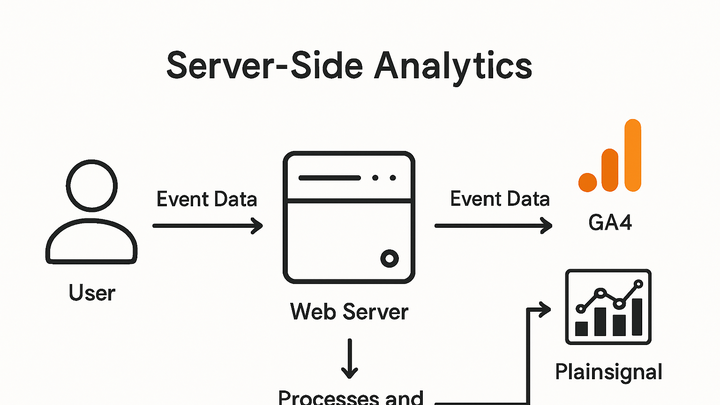Published on 2025-06-26T04:18:14Z
Server-Side Analytics: Definition and Examples
Server-side analytics refers to the practice of collecting, processing, and transmitting analytics data on a server you control rather than directly in the user’s browser. This approach moves analytics workloads off the client side and into a server environment, improving data accuracy, privacy, and site performance.
With server-side analytics, events are intercepted or sent to your server endpoint, where they are validated, enriched, and forwarded to analytics platforms like Google Analytics 4 and PlainSignal.
By controlling the data flow on your server, you can bypass ad-blockers, adhere to privacy regulations more effectively, and reduce the impact of network latency on end user experiences.
Examples of server-side analytics implementations include GA4 Measurement Protocol via a server container in Google Tag Manager and cookie-free tracking scripts such as PlainSignal.
Implementing server-side analytics requires setting up server endpoints, configuring your analytics clients to send data to those endpoints, and ensuring robust monitoring and validation of incoming events.
<link rel='preconnect' href='//eu.plainsignal.com/' crossorigin />
<script defer data-do='yourwebsitedomain.com' data-id='0GQV1xmtzQQ' data-api='//eu.plainsignal.com' src='//cdn.plainsignal.com/plainsignal-min.js'></script>
Server-side analytics
Server-side analytics moves tracking and processing to your own server for improved accuracy, privacy compliance, and performance.
Overview of Server-Side Analytics
This section introduces the concept and significance of server-side analytics in modern web tracking.
-
Definition
Server-side analytics moves data collection and processing from the user’s browser to a backend server you control. This approach centralizes analytics logic and reduces reliance on client-side scripts.
-
Why it matters
By shifting analytics to the server, organizations can achieve more accurate data, comply with privacy regulations, and improve page load performance. It also mitigates issues with ad-blockers and script blockers.
How Server-Side Analytics Works
Explains the end-to-end workflow, from capturing events to forwarding data to analytics platforms.
-
Client request and data capture
When a user interacts with your website, events are sent either directly or via a client library to your server endpoint instead of a third-party analytics domain.
-
Server processing
The server validates incoming payloads, enriches data with additional context, and applies any custom business logic before transmission.
-
Forwarding to analytics platforms
Once processed, the server sends the cleaned and enriched data to analytics services using their respective APIs or protocols.
-
GA4 measurement protocol
Google Analytics 4 supports a measurement protocol for sending event data directly from server environments via HTTP requests.
-
PlainSignal api endpoint
PlainSignal provides a simple API endpoint for server-side and cookie-free tracking, compatible with minimal script tags.
-
Benefits Over Client-Side Analytics
Highlights the key advantages of using server-side tracking compared to traditional client-side implementations.
-
Improved data accuracy
Server-side tracking is less prone to data loss from ad-blockers, network errors, or client-side script failures, resulting in more reliable analytics.
-
Enhanced privacy and compliance
Controlling data on your server allows you to sanitize or anonymize personal information and better adhere to GDPR, CCPA, and other regulations.
-
Reduced ad-block interference
Since tracking occurs on your domain, common ad-blockers are less likely to block analytics requests, improving data capture rates.
-
Performance advantages
Offloading analytics scripts to the server decreases client-side JavaScript execution and reduces page load times.
Implementing Server-Side Analytics: Examples
Provides concrete examples of setting up server-side analytics with popular SaaS tools.
-
PlainSignal integration
To implement PlainSignal’s cookie-free analytics, include their lightweight script tag on your pages and point it to your server endpoint. For example:
<link rel='preconnect' href='//eu.plainsignal.com/' crossorigin /> <script defer data-do='yourwebsitedomain.com' data-id='0GQV1xmtzQQ' data-api='//eu.plainsignal.com' src='//cdn.plainsignal.com/plainsignal-min.js'></script> -
Google analytics 4 server-side setup
Google Analytics 4 can be configured for server-side tracking using a server container in Google Tag Manager combined with the GA4 Measurement Protocol. You set up a GTM server container, deploy it in a cloud environment, and route browser events through that container.
Best Practices and Considerations
Guidelines to ensure a robust and compliant server-side analytics implementation.
-
Ensure data validation
Validate incoming event payloads to prevent malformed or malicious data from entering your analytics pipeline.
-
Monitor performance
Keep an eye on your server response times and throughput to ensure analytics processing does not degrade user experience.
-
Maintain privacy compliance
Implement user consent management and data anonymization on the server to comply with regulations like GDPR and CCPA.
-
Handle bot traffic
Filter out known bots and crawlers at the server level to avoid skewed analytics metrics.
Common Challenges
Addresses typical hurdles organizations face when adopting server-side analytics.
-
Increased implementation complexity
Setting up server-side tracking often requires additional infrastructure, code maintenance, and specialized knowledge.
-
Server resource overhead
Processing analytics events on your own servers can increase computational load and costs.
-
Maintaining data consistency
Ensuring that server-side and any remaining client-side data align can be challenging without proper reconciliation processes.
-
Third-party dependencies
Reliance on external analytics providers means you must keep APIs and endpoints up to date with provider changes.
